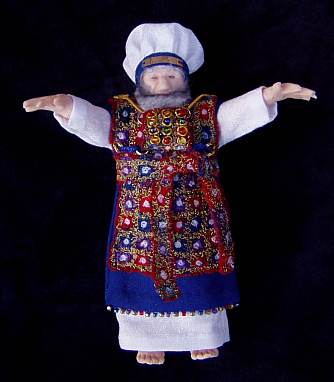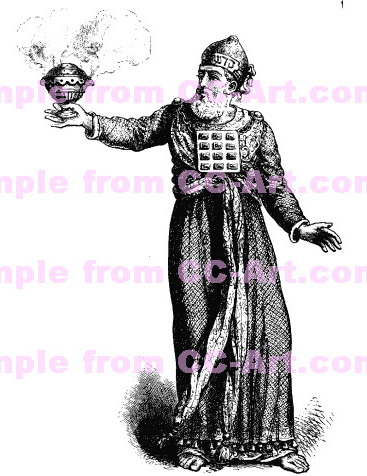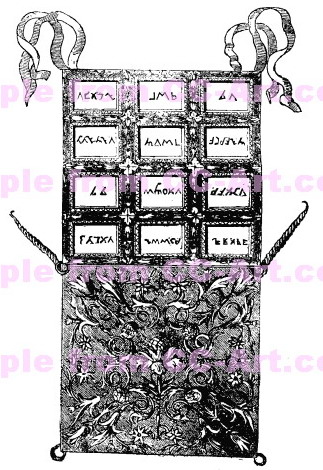![]()
Jewish High Priests
High Priest: the chief priest of the Jewish priesthood; spiritual leader of ancient Israel; the successor of Aaron (although
Aaron was not called a "high priest"): the high priest was regarded as the intermediary between God and man, and as such
he was accorded special consideration, as the wearing of vestments appropriate to his high office (Ex. 28) and anointment (the only priest so honored, Ex. 29: 7) he was subject to specific prohibitions, as being forbidden to have his head uncovered (Lev. 21:10); and he was obligated to perform certain sacred duties, as the offering to God of sacrifices on the day of atonement in asking forgiveness for Israel's sins (Heb. 9:25): he also presided over the Sanhedrin (John 18:13,15,22).

The Scriptures describing his dress can be found in the
Bible, in Exodus 28 and 39.
The High Priest wears 8 items of clothing:
Linen breeches,
White linen tunic,
Girdle of white linen with blue, purple and red interwoven, (not visible)
Blue robe, hemmed with bells and pomegranates,
Ephod, made of white linen, blue, purple and scarlet with gold,
Breastplate, attached to the ephod, made of the same materials as the ephod,
White headdress
\


ABOVE: Reconstruction of the garments of the high priest. Cf. Exod.28:2


LEFT: High Priest's breastplate;
RIGHT: The twelve stones of the breast-plate They were (left to right, top to bottom): Sard-Carnelian, Plasma, Jasper-Agate, Turquoise, Lazurite, Chalcedony, Amber, Agate, Amethyst, (Fourth row) Mother of Pearl, Black Onyx and Jasper-Onyx.

1. UNDER-TUNIC OR UNDERSHIRT (Tabbard):
worn in this case as an outer-garment, on top of all the other garments. Of a silky, satiny fabric (fine linen--lingerie), basically white in color, as an example of purity and righteousness, with a diminutive (barely noticeable) pattern, similar to the Medieval Tunic, of a golden grapevine (like on the Temple door), decorated with precious jewels as grapes. (Biblical ephod Exodus 28:4 or sack-garment with shoulder stone pins, holding it together: the curious girdle Exodus 28:8-12.)2. MEDIEVAL TUNIC OR LONG UNDERSHIRT (Surcoat):
also, worn in this case as an outer-garment, on top of the Long Gown or Medieval Robe but under the Tabbard. Of a silky, satiny fabric (fine linen--lingerie), deep sky-blue color, and decorated with a larger, bolder pattern of needlework: green leaves and grape vines with bunches of red and purple grapes, symbolic of God's Kingdom and Holy Bride of Israel. Originally, of gold vines (as the Under-Tunic, above still is Exodus 28:5) but now, in this Age, of living green color--even as Aaron's metal rod sprouted Numbers 17:8 (Biblical embroidered coat Exodus 28:4 and larger ephod or sack-garment Exodus 28:6-7.)3. MEDIEVAL GOWN OR FULL-LENGTH SHIRT:
worn in this case as an under-garment, beneath all the other garments. And about the bottom, were hung an alternating group of bells and pomegranates (so that as the High-Priest walked, he would make a tinkling sound). Most likely of a dark blue or navy color (or perhaps deep purple--blood color) and probably of fine linen (lingerie) or silk. (Biblical robe Exodus 28:4 or long official's garment.)*** NOTE: the girdle or Belt of Judgment about his waist was checkered of sorts, being made of black and white beads, that formed holy symbols and letters.
Links